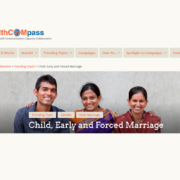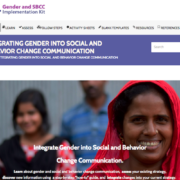Compilation of Resources to End Child Marriage Is Health COMpass’ Latest Trending Topic
In the last decade, child, early and forced marriage has affected about 58 million girls.
Many of these girls are extremely young – some as young as eight –and are married against their will. In some cultures, every seventh girl is married before she reaches the tender age of 15, an age when she should just be finding out about herself, her body and her potential.

Billboard from UNICEF’s “My Childhood, My Right” campaign in India – The girl says: No Marriage Now – I want to be big (respectable). My parents will proudly say – this is our daughter!
Marrying girls at this age essentially cuts off their chances at a full life – their education stops, they begin having children – and whatever plans they dreamed of for their own futures are not to be. Moreover, it’s not just girls that are affected; according to UNICEF, 156 million men alive today were married as children.
Yet another challenge with the early marriage phenomenon is that first pregnancies in many cultures, are expected immediately after marriage – possibly to prove fertility. Thus for the young girl, she is not only forced into marriage, but is expected to birth and raise a baby within the first year.
There is a deadly side to child marriage – girls under 15 are five times more likely to die in childbirth than women in their 20s and much more likely to experience complications of childbirth. Being young with little or no power to speak for themselves, they are therefore at greater risk of contracting HIV and other sexual transmitted diseases.
Child, early and forced marriage is seen as a human rights violation worldwide and works against the global efforts being made to improve maternal health, education, food security and gender equality for girls. Social and behavior change communication (SBCC) plays a vital role in raising awareness and inspiring action at all levels of society about the dangers of early marriage.
The Health COMpass presents a selection of tools and project examples in its new Trending Topic – Child, Early and Forced Marriage.









Leave a Reply
Want to join the discussion?Feel free to contribute!